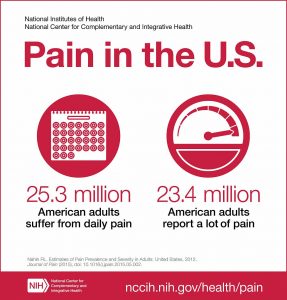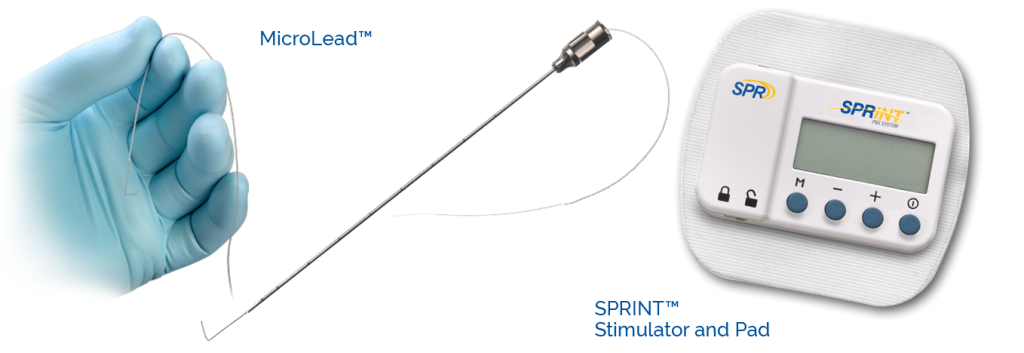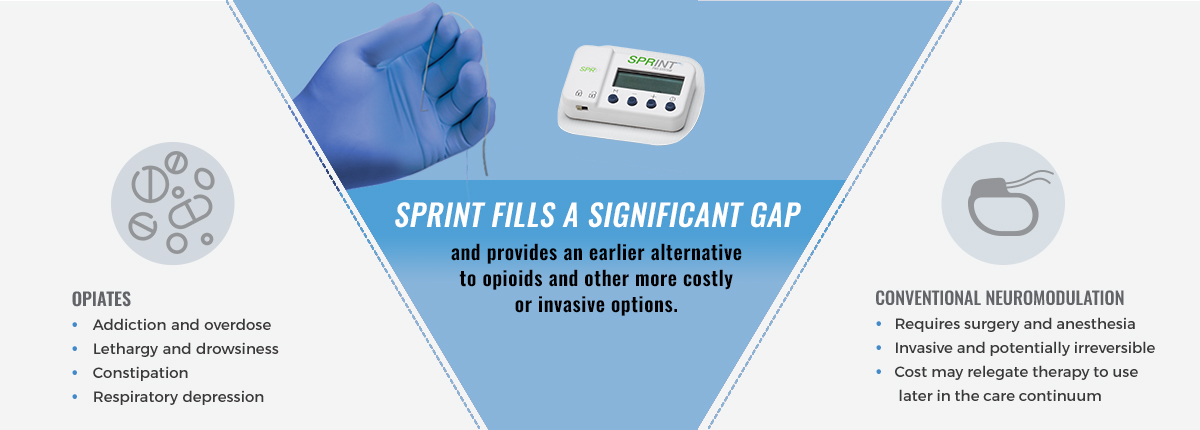Last spring, I wrote about using physical therapy as an alternative to opioids to treat chronic pain. When the CDC released their opioid prescription guidelines last March, they emphasized that non-opioid therapy was the preferred treatment of chronic pain. Since then, the healthcare industry has been ramping up efforts to decrease opioid prescriptions, curb opioid overdoses, and find a new opioid alternative.
With the use of new and emerging technologies, health tech companies are designing neurostimulation devices as a new opioid alternative. Some of these devices show promise in delivering significant pain relief without the use of drugs, permanent implants, or anesthesia. For chronic and acute pain sufferers who don’t want to use opioids to manage their pain, relief may be on the way!
Chronic Pain by the Numbers
 Chronic pain is typically defined as pain that lasts for more than three months caused by disease, injury, or unknown sources. According to the National Institutes of Health’s 2012 National Health Interview Survey (NHIS), nearly 40 million adults reported experiencing severe levels of pain. Over 23 million American adults reported having pain every day for the three months preceding the study.
Chronic pain is typically defined as pain that lasts for more than three months caused by disease, injury, or unknown sources. According to the National Institutes of Health’s 2012 National Health Interview Survey (NHIS), nearly 40 million adults reported experiencing severe levels of pain. Over 23 million American adults reported having pain every day for the three months preceding the study.
The major issue is that opioids are commonly prescribed as a long-term treatment for those with chronic pain. This has led to substance abuse and dependency by millions of American adults. Each day, 40 U.S. adults die from a prescription opioid overdose. The increasing number of people misusing opioids has prepped the stage for the emergence of safe, effective pain management methods.
The New Opioid Alternative: The Sprint PNS System
With pain specialists looking for better treatment methods, medical device designers have stepped into the $635 billion pain management industry. These sorts of devices are new because it is only now that science and technology have advanced enough to make small enough devices. SPR Therapeutics has been developing a peripheral nerve stimulation (PNS) device to treat chronic pain.
For all my physicians or therapists, I want to note that peripheral nerve stimulation therapy differs from peripheral field stimulation (PFS), percutaneous electrical nerve stimulation (PENS), and spinal cord stimulation (SCS). These stimulation methods do not deliver the same therapy as Sprint PNS.
The company is finding great success with their FDA-cleared new opioid alternative. In fact, Sprint PNS clinical data shows that 72 percent of patients treated with the system experienced significant pain relief. Even more promising, 78 percent of participants reported continued pain relief at the 12-month post-treatment mark. Participants had shoulder pain, post-amputation pain, lower back pain, or postoperative pain, and at least 67 percent of each group reported relief of pain.
How the Sprint PNS system works
The Sprint PNS device was cleared in July of last year to treat peripheral pain in the lower back and extremities. Peripheral pain is a type of nerve pain that flows from every part of the body, through the spinal cord, and into the brain. The Sprint PNS system (and other peripheral nerve stimulation devices) essentially block or interfere with the pain signal as it moves from the nerves to the brain in the body.

This is all done without drugs, permanent implants, surgery, anesthesia, or incisions. A doctor will slip a thin, thread-like wire into the patient’s arm. This will get calibrated with a small Apple Watch-size device that will control stimulation. It will feel like a massage or slight vibrations through the muscles. After a few months, clinical trials have shown, that the pain has usually subsided, and the device is removed.
Exploring the Benefits of Neurostimulation in Pain Management
SPR Therapeutics designed this device to bridge the gap in pain management treatment options. Sprint PNS has the potential to emerge as the standard of care to treat chronic pain.
One major benefit of neurostimulator devices like the Sprint PNS system is that with FDA-approval, Medicare and most types of insurance can likely cover their costs. Combined with other treatments, PNS is the ideal opioid alternative treatment. Used in combination with other treatment methods like over-the-counter meds and physical therapy, PNS has the potential to eliminate pain altogether.

The procedure is non-invasive with no incisions, let alone surgery. Most PNS systems require a permanent implant but the Sprint PNS device was designed for removal after 30 days. The device doesn’t interfere with most health conditions, so many patients can benefit from the new technology.
Potential Risks of PNS Devices
Though the devices do not interfere with most other health issues, individuals with pace monitor should not use Sprint PNS devices. The neurostimulation could interfere with their heart-monitoring device. Like any implant, permanent or temporary, there is the risk of infection. With Sprint PNS device, they use a coiled micro lead to reduce the risk of infection by 25 times.
Because this is a new technology, if someone has to pay out of pocket for the services, costs can run into the tens of thousands. However, with the nation in an opioid epidemic, one would have to assume that physicians, therapists, insurers, and legislators would be quick to remove any obstacles in the way of making this the new opioid alternative.
As we look to the future of pain management and the expanding access to physical therapists across the country, we should expect to see peripheral nerve stimulation systems like Sprint PNS become the standard of chronic pain care.
